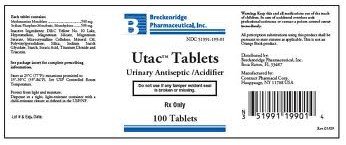| 扁桃酸乌洛托品:治疗和预防慢性单纯性下尿道感染, 无症状性菌尿 禁忌:肝肾功能不全, 严重脱水者禁用。 注意事项:代谢性酸中毒, 痛风, 妊娠哺乳期妇女慎用。 不良反应:恶心, 呕吐, 腹泻, 消化不良, 皮疹, 尿道特别是膀胱刺激和炎症,尿痛,尿频,蛋白尿和血尿。 药物相互作用:与尿液碱化剂、抗酸剂、枸橼酸钾及利尿剂如乙酰唑胺和噻嗪类合用,本药作用减弱。抗坏血酸或氯化铵会使尿液酸化,增加本药的作用。 严重药物相互作用:与磺胺类药合用,会导致结晶尿,避免合用。 FDA妊娠分级:C级: 动物研究证明药物对胎儿有危害性(致畸或胚胎死亡等),或尚无设对照的妊娠妇女研究,或尚未对妊娠妇女及动物进行研究。本类药物只有在权衡对孕妇的益处大于对胎儿的危害之后,方可使用。 药理作用:是一种合成的用于治疗慢性泌尿系统感染的抗菌素,抑制或预防疾病。以马尿酸盐或苯乙醇酸盐的形式存在。该药在酸性尿液中转变为甲醛发挥抗菌活性。 吸收:胃肠道容易吸收。 分布:能通过胎盘和进入乳汁。 排泄:几乎全部经尿液排泄。 ---------------------------------------------------------------
DESCRIPTION CLINICAL PHARMACOLOGY INDICATIONS AND USAGE Prophylactic Use Rationale:Urine is a good culture medium for many urinary pathogens. Inoculation by a few organisms (relapse or reinfection) may lead to bacteriuria in susceptible individuals. Thus, the rationale of management in recurring urinary tract infection (bacteriuria) is to change the urine from a growth-supporting to a growth-inhibiting medium. There is a growing body of evidence that long-term administration of methenamine can prevent recurrence of bacteriuria in patients with chronic pyelonephritis. Therapeutic Use Rationale:Helps to sterilize the urine and, in some situations in which underlying pathologic conditions prevent sterilization by any means, can help to suppress bacteriuria. As part of the overall management of the urinary tract infection, a thorough diagnostic evaluation should accompany the use of this product. UROQID-Acid® No.2 contains approximately 83 mg of sodium per tablet and should be used with caution in patients on a sodium-restricted diet. Sodium phosphates should be used with caution in the following conditions: cardiac failure; peripheral or pulmonary edema; hypernatremia; hypertension; toxemia of pregnancy; hypoparathyroidism; and acute pancreatitis. High serum phosphate levels increase the incidence of extraskeletal calcification. Large doses of methenamine (8 grams daily for 3 to 4 weeks) have caused bladder irritation, painful and frequent micturition, albuminuria and gross hematuria. Dysuria may occur, although usually at higher than recommended doses, and can be controlled by reducing the dosage. This product contains a urinary acidifier and can cause metabolic acidosis. Care should be taken to maintain an acidic urinary pH (below 5.5), especially when treating infections due to urea-splitting organisms such as Proteus and strains of Pseudomonas. Drugs and/or foods which produce an alkaline urine should be restricted. Frequent urine pH tests are essential. If acidification of the urine is contraindicated or unattainable, use of this product should be discontinued. Information For Patients:To assure an acidic pH, patients should be instructed to restrict or avoid most fruits, milk and milk products, and antacids containing sodium carbonate or bicarbonate. Laboratory Tests:As with all urinary tract infections, the efficacy of therapy should be monitored by repeated urine cultures. During long-term therapy, careful monitoring of renal function, serum phosphorus and sodium may be required at periodic intervals. Laboratory Test Interactions: Formaldehyde interferes with fluorometric procedures for determination of urinary catecholamines and vanilmandelic acid (VMA) causing erroneously high results. Formaldehyde also causes falsely decreased urine estriol levels by reacting with estriol when acid hydrolysis techniques are used; estriol determinations which use enzymatic hydrolysis are unaffected by formaldehyde. Formaldehyde causes falsely elevated 17-hydroxycorticosteroid levels when the Porter-Silber method is used and falsely decreased 5-hydroxyindoleacetic acid (5HIAA) levels by inhibiting color development when nitrosonaphthol methods are used. Carcinogenesis, Mutagenesis, Impairment Of Fertility: Long-term animal studies to evaluate the carcinogenic, mutagenic, or impairment of fertility potential of this product have not been performed. Pregnancy:Teratogenic Effects. Pregnancy Category C. Animal reproduction studies have not been conducted with UROQID-Acid® No.2. It is also not known whether this product can cause fetal harm when administered to a pregnant woman or can affect reproductive capacity. Since methenamine is known to cross the placental barrier, this product should be given to a pregnant woman only if clearly needed. Nursing Mothers:Methenamine is excreted in breast milk. Caution should be exercised when this product is administered to a nursing woman. ADVERSE REACTIONS Gastrointestinal upset (diarrhea, nausea, stomach pain, and vomiting) may occur with the use of sodium phosphates. Also, bone or joint pain (possible phosphate induced osteomalacia) could occur. The following adverse effects may be observed (primarily from sodium): headaches; dizziness; mental confusion; seizures; weakness or heaviness of legs; unusual tiredness or weakness; muscle cramps; numbness, tingling, pain, or weakness of hands or feet; numbness or tingling around lips; fast or irregular heartbeat; shortness of breath or troubled breathing; swelling of feet or lower legs; unusual weight gain; low urine output, unusual thirst. DOSAGE AND ADMINISTRATION HOW SUPPLIED |
UTAC(扁桃酸乌洛托品片)简介:
扁桃酸乌洛托品:治疗和预防慢性单纯性下尿道感染, 无症状性菌尿 禁忌:肝肾功能不全, 严重脱水者禁用。
注意事项:代谢性酸中毒, 痛风, 妊娠哺乳期妇女慎用。
不良反应:恶心, 呕吐, 腹泻, 消化不良 ... 关键字:UTAC(扁桃酸乌洛托品片)
责任编辑:admin
|
最新文章更多
推荐文章更多
热点文章更多 |


